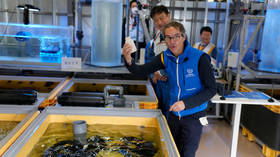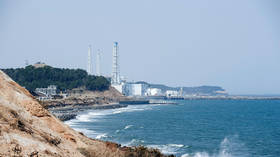‘Nuclear’ Fukushima water is toxic, but not the way you think

On August 24, the discharge of radioactive water from the Fukushima Daiichi Nuclear Power Plant into the Pacific Ocean began and there has been a metric ton of self-referential misinformation spread online that plays on people’s inability to read dense scientific reports and their fear of the nuclear industry.
While most of the people with strong opinions on the matter essentially have one argument, that the International Atomic Energy Agency (IAEA) is party to a Japanese government conspiracy, and cannot be reasoned with as such, perhaps some folks may benefit from some good-faith discussion.
For starters, it should be noted that the contents of the water being discharged are virtually the same as regular nuclear wastewater. This fact has been muddled and people are sharing a crude MS Paint diagram to show the difference between normal nuclear waste water and contaminated water from Fukushima. What this diagram misses primarily is that the water is not going as-is directly into the ocean but instead being treated through a process called Advanced Liquid Processing System (ALPS) and diluted thereafter.
Without getting into the specifics, ALPS essentially helps to take out the heavier radioactive elements from the water after treatment and pure seawater dilution. That process was largely successful but mostly left tritium, which could not be removed via ALPS and needs further dilution. Many people are upset that the current testing is only looking for tritium. They claim that the IAEA should be looking for more. The reason the IAEA is not is because the ALPS process was already verified as successful.
However, some folks claim that the IAEA admitted that all the data was supplied by the Japanese government and the Tokyo Electric Power Company (TEPCO), as if the IAEA itself was shouldered out of any transparent process. For example, a highly-shared report from the explicitly anti-nuclear organization, Friends of Earth (FoE), says exactly this. The problem is that this claim is false. The IAEA verified the results of the tests by doing their own testing in conjunction with other independent labs around the world.
Some others point to a few lines within the IAEA’s own report that says that the paper is not an endorsement of any policy and that the agency takes no liability for the information or links provided. First of all, it must be noted that it is standard for multilateral institutions not to recommend specific policies to governments since these are political and budgetary concerns that should be decided by states.
Moreover, the IAEA's role in this case is to assess, oversee, and review the accuracy of TEPCO’s processes. The agency has a facility on-site where it observes all processes and measurements and sends samples to different labs for independent testing.
But this entire non sequitur ignores what the IAEA is trying to do altogether. The IAEA’s lab testing, which you can find in its report here, seeks to answer one key question: If we gather water the same way TEPCO did, and test for the same things TEPCO did, do we get the same results? According to the results of the IAEA and the independent labs, the answer to that specific question is yes. But remember: The role of the IAEA is to verify and validate, not endorse.
Some folks are saying that the testing only covered 3% of the tank groups. While that’s true, specifically targeting the K4-B tank group, that’s because that’s the group of tanks that are now being discharged. However, the IAEA says itself (page 114 of this report) that it will be verifying TEPCO’s results for every single tank group over the 30-year discharge period.
To give detractors some space here, it should be noted that there always exist concerns around technological and environmental decisions, and these concerns are legitimate because they contain some degree of risk (however small). The question is, how much risk are we willing to accept? The problem, as most in the scientific community see it, is that the risks are being blown up by detractors and improperly framed. But they are, to be fair, not zero.
For instance, we accept some measure of risk when we board an airplane or, worse, operate a motor vehicle. There is a chance, however small, that a wreck could happen. But the issue with nuclear energy in general is that the public demands – no doubt because of high-profile nuclear catastrophes – an unreasonably low level of risk. For the Fukushima water, the concern is truly not that it is any worse off than normal nuclear wastewater, but rather that it was generated from an accident and that it came from Fukushima, which conjures up apocalyptic imagery for some people.
It’s also fair to say that, first of all, the Japanese government is pretty awful. We’re talking about one of the principal war-criminal regimes of World War II that not only hasn’t apologized for its atrocities but actively celebrates its activities during that conflict. No amount of Kawaii imagery and merchandise can wipe that one away. More to the point at hand, TEPCO is also an abomination of a company that has routinely lied about pretty much all of its data when it comes to safety and has been found liable in court for refusing to yield to relevant warnings about seismic activity with regard to Fukushima. But that’s where the IAEA comes in.
For us to not believe that the water is as safe as being claimed would require us to believe that the IAEA is engaged in a conspiracy with TEPCO and Japan, which is a ridiculous claim to make without hard evidence. Given that no one has been able to furnish evidence of impropriety by the IAEA, this cannot be a serious part of this discussion – instead, this discussion is really all about the amount of permissible risk, as noted above.
Finally, there’s also no doubt that Japan is being given diplomatic cover over this issue that other countries wouldn’t receive. For example, if it were China or Russia discharging contaminated water from a major disaster, there’s little doubt that Western governments would pressure Beijing or Moscow to stop regardless of what the IAEA concludes. This actually happened to Russia in 1993 after international pressure, particularly from Japan and the US, when Moscow originally planned to dump low-level nuclear waste into the Sea of Japan. China is also being accused of double standards for being against Japan’s discharge, despite itself dumping huge amounts of nuclear wastewater into the ocean every year.
Anyway, while this would most certainly be the case with China or Russia today, and it does reflect inequality in the application of diplomatic norms, it’s a hypothetical scenario. China and Russia are not being accused of nuking the ocean today. In reality, the criticisms leveled against Japan in this case are mostly highly exaggerated, misinformed, and do not adhere to the basic principles of science, while also undermining a key multilateral institution, the IAEA.
For reliable information on this topic, I highly recommend a column by nuclear engineer Julien de Troullioud de Lanversin for the South China Morning Post, as well as X (formerly Twitter) threads by energy consultant David Fishman on the IAEA report and the FoE post. This piece was written with heavy reference to these sources, plus correspondence with the two experts themselves.
The statements, views and opinions expressed in this column are solely those of the author and do not necessarily represent those of RT.
















